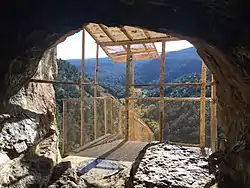Sandia Cave
Sandia Cave, also called the Sandia Man Cave, is an archaeological site near Bernalillo, New Mexico, within Cibola National Forest. First discovered and excavated in the 1930s, the site exhibits evidence of human use from 9,000 to 11,000 years ago. It was declared a National Historic Landmark in 1961.[2] The site is open to the public, up a difficult half-mile trail off New Mexico State Road 165.
Sandia Cave | |
 View from inside the cave. | |
  | |
| Nearest city | Bernalillo, New Mexico |
|---|---|
| Coordinates | 35°15′17″N 106°24′22″W |
| Area | 130 acres (53 ha) |
| NRHP reference No. | 66000487[1] |
| Significant dates | |
| Added to NRHP | October 15, 1966 |
| Designated NHL | January 20, 1961[2] |
Description
The Sandia Cave is located on a steep side wall of Las Huertas Canyon, on the north side of the Sandia Mountains northeast of Albuquerque, New Mexico. The public trailhead to access the cave is on the east side of NM165. The site is rather difficult to reach, as it is requires traversing ledges and a steep metal staircase.[3]
History
The cave was discovered in 1936.[4] Archaeologists argued about claims associated with this site for decades, making it difficult to determine its importance.[5] The site was excavated in the 1930s and 1940s by Frank Hibben while at the University of New Mexico.[6][7]
Both Folsom and Sandia hunting points were recovered, with the hitherto unknown Sandia points interpreted by Hibben as being much older than any other evidence of man in North America. Faunal remains included extinct, Pleistocene mammals.[7] Later study of stratigraphy and radiometric dates corrected serious earlier misinterpretations, leaving "Sandia Man" as definitely younger than earlier claimed.[8]
Faunal remains recovered by Hibben and others include such extinct forms as mammoth, mastodon, sloth, horses, and camels, as well as many mammal and bird species that survived the end of the Pleistocene, making this one of the most important Pleistocene paleontological sites in northern New Mexico.[9]
See also
References
- "National Register Information System". National Register of Historic Places. National Park Service. July 9, 2010.
- "National Historic Landmarks Survey, New Mexico" (PDF). National Park Service. Retrieved January 2, 2017.
- "Sandia Cave". Retrieved 4 April 2011.
- "Sandia Man Cave". USFS. Retrieved 2017-04-14.
- Preston, Douglas. 1995. The mystery of Sandia Cave. New Yorker 71:66-72.
- Hibben, F. C. 1937. Association of man with Pleistocene mammals in the Sandia Mountains, New Mexico. American Antiquity 2:260-263.
- Hibben, F. C. 1941. Evidences of early occupation in Sandia Cave, New Mexico, and other sites in the Sandia-Manzano region. With appendix on correlation of the deposits of Sandia Cave, New Mexico, with the glacial chronology. Smithsonian Miscellaneous Collections 99(23).
- Haynes, C. V., Jr., and G. A. Agogino. 1986. Geochronology of Sandia Cave. Smithsonian Contributions to Anthropology 32:1-32.
- http://www.utep.edu/leb/pleistNM/sites/sandiacave.htm